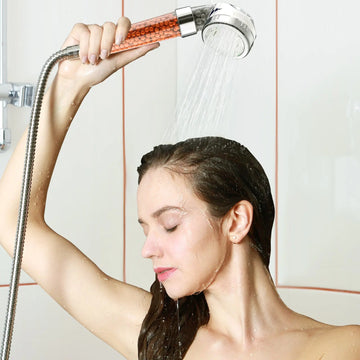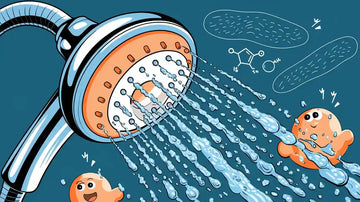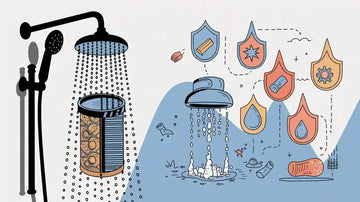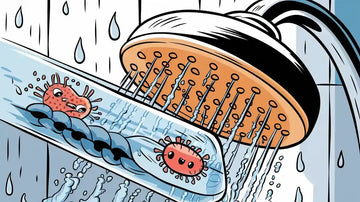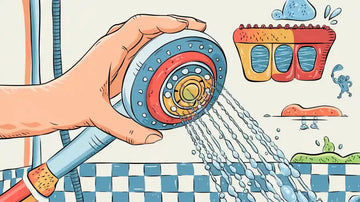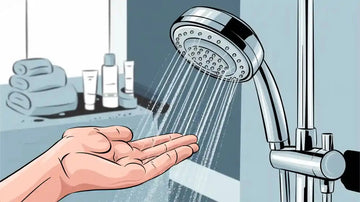Many people see dry skin or dull hair after showers, but they do not know water quality matters a lot. Filter shower heads use special filter media to take out bad things from shower water. These shower heads remove things like chlorine and hard minerals. Studies show these can take away natural oils and hurt skin and hair. Bad water can cause itchy skin, dryness, and weak hair. A filter shower head gives cleaner water by using many filter layers inside. These filters help keep you healthy, make water better, and protect your skin and hair. Picking a filtered shower head gives you clean water every time.
Key Takeaways
Filter shower heads take out chlorine, heavy metals, and other bad things. This helps protect your skin and hair. Multi-stage filters have layers like KDF-55, activated carbon, and calcium sulfite. These layers help clean water well. Filtered water keeps your skin soft and your hair healthy. It also lowers your contact with harmful chemicals. Good filters do not make water pressure drop. They are simple to put in and easy to take care of if you change the filter often. Picking a certified filter that fits your water type gives you safer and cleaner showers every day.
How Filter Shower Heads Work
Filtration Process Overview
A filter shower head has many layers to clean water. Each layer removes different bad things. When water goes into the showerhead, cleaning starts. First, a mesh or sand filter catches big stuff like sand and rust. Then, water moves through other filters that take out chemicals and metals.
Here is how shower filters work step by step:
Pre-filtration: Mesh or sand filters catch big dirt and pieces.
Primary filtration: KDF-55 takes out chlorine and heavy metals with a redox reaction.
Secondary filtration: Activated carbon grabs organic stuff and bad smells.
Polishing stage: Calcium sulfite or vitamin C gets rid of leftover chlorine and other things.
Tip: Multi-stage shower filters work better because each part removes certain bad things.
The table below shows the main filter types in showerheads and what they do:
Filtration Media |
Claims/Effectiveness |
How It Works |
Scientific View |
|---|---|---|---|
Carbon Block |
Takes out chlorine, organic stuff, makes water smell better |
Grabs things on the carbon’s tiny holes |
Good for chlorine and VOCs, not great for minerals |
KDF |
Lowers chlorine, heavy metals, stops bacteria |
Changes bad stuff into safe things with a redox reaction |
Good for chlorine and metals, not for hard minerals |
Vitamin C |
Gets rid of chlorine and chloramines |
Breaks down chlorine and chloramines with a chemical reaction |
Great for chlorine, not for minerals or heavy metals |
Zeolite |
Removes heavy metals, ammonia |
Swaps ions and grabs things physically |
Good for some metals and ammonia, not for chlorine or hard water |
Tourmaline |
Softens water, helps pH, makes negative ions |
Makes weak electric charges that change water a little |
Not much science proof, mostly stories |
Maifan Stone |
Adds minerals, balances pH |
Puts tiny minerals in water and grabs some bad stuff |
Not best for chlorine or metals, may not make a big change |
Calcium Sulfite |
Takes out chlorine, works well in hot water |
Changes chlorine into safe salts |
Very good for chlorine, not for hard water or heavy metals |
FIR Ceramic Balls |
Makes water better, softens water |
Sends out far-infrared rays that may make water clusters smaller |
Not much science proof, not good alone |
A shower filter shower head often uses more than one of these. This helps remove more bad things from water. The filter makes water feel softer and smell nicer.
Inside a Filtered Shower Head
Inside a filtered shower head, there is a small cartridge with many filter layers. Each layer does something special. The main goal is to take out chlorine, heavy metals, and organic stuff. The way the layers are put together helps clean water well.
Here is what you usually find inside filtered showerheads:
Filter Media |
Mechanism(s) |
Targeted Contaminants |
Description |
|---|---|---|---|
Carbon Block |
Grabs things |
Chlorine, organic stuff |
Tiny holes in carbon catch bad things. |
KDF (Copper/Zinc) |
Redox reactions |
Chlorine, heavy metals (lead, mercury) |
Changes chlorine and metals into safe things. |
Vitamin C |
Chemical neutralization |
Chlorine, chloramines |
Breaks down chlorine and chloramines. |
Zeolite |
Ion exchange, grabs things |
Heavy metals, ammonia |
Tiny holes in mineral catch bad stuff. |
Calcium Sulphite |
Chemical reaction |
Chlorine |
Changes chlorine into safe salts, works well in hot water. |
A filtered shower head may use a mix of these filters. Water goes through each layer one after another. Each layer takes out more bad things. This way, shower filter heads clean water really well.
How long a filter lasts depends on the type and how much water you use. The chart below shows how long KDF, carbon, and vitamin C filters last:
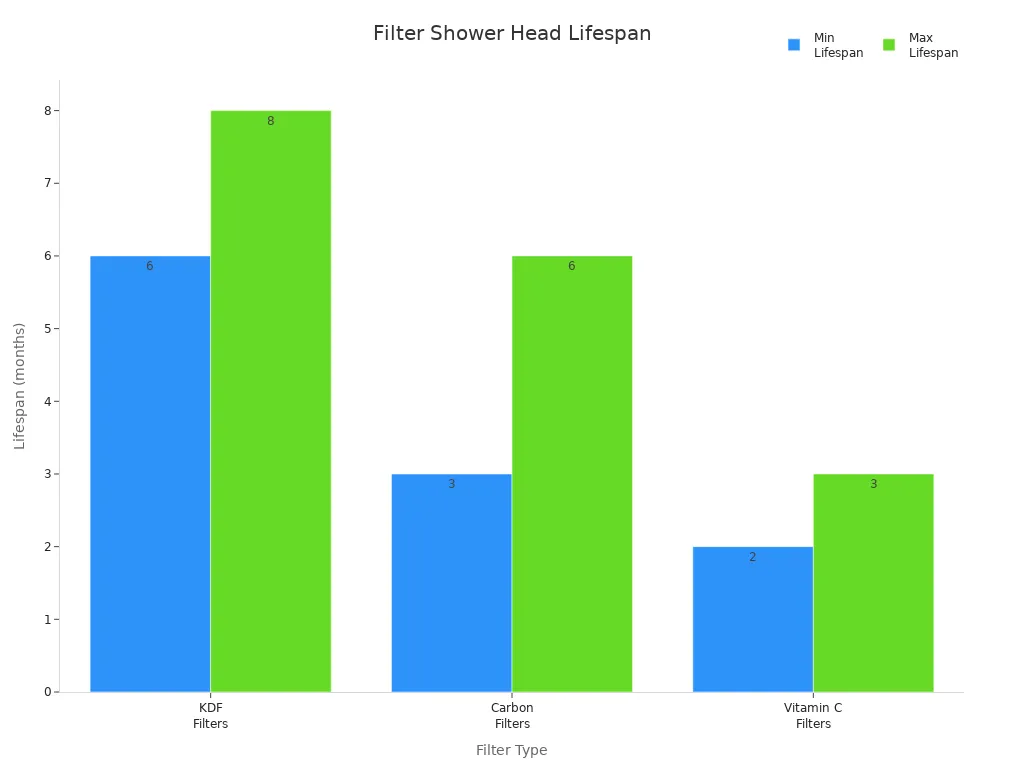
Most KDF filters last 6-9 months. Carbon filters last 3-6 months. Vitamin C filters need to be changed every 2-3 months. If water pressure drops, the smell changes, or you see dirt, it is time to change the filter.
Note: Change the filter often so it keeps working well.
A filter shower head like the Cobbe DS uses many filter stages. It has KDF-55, calcium sulfite, and mineral balls. This design takes out over 99% of chlorine and heavy metals. It makes shower water safer for your skin and hair. The small cartridge fits inside the showerhead, so it is easy to put in and change.
A shower filter shower head makes water better by using smart filters and design. The filter keeps bad things out and gives you a nicer shower.
Water Contaminants in Showers
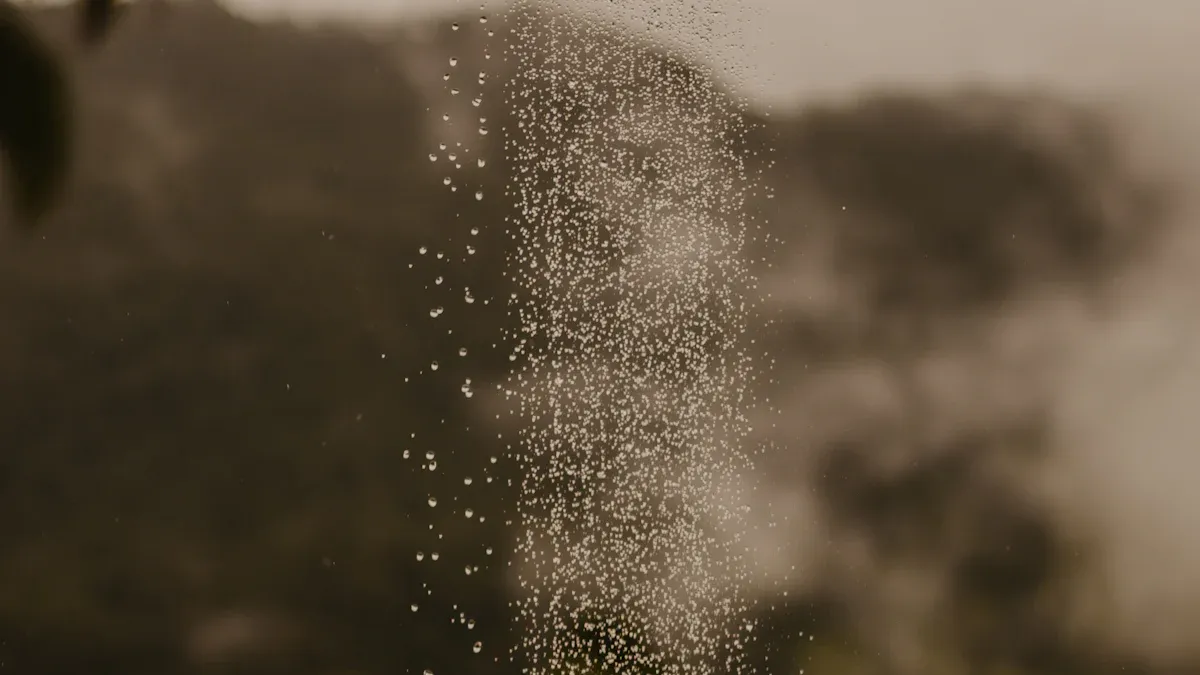
Chlorine and Chloramines
Cities put chlorine and chloramines in water to kill germs. These chemicals make water safer to drink. But they can cause problems when you shower. Hot water makes chlorine and chloramines go into the air. People breathe them in while showering. These chemicals also touch your skin. They can make your skin dry and your eyes itchy. Some people get rashes from them. People with asthma may cough more or have trouble breathing. Chloramines can be even worse for your lungs than chlorine. Some studies say showering with chlorine can raise cancer risk. This is because of byproducts called trihalomethanes. These chemicals can also upset the good bacteria in your body. Many people use filters to take out chlorine and make water better.
Tip: A shower filter can help take out chlorine and chloramines. This makes showers safer and more comfortable.
Heavy Metals
Heavy metals get into shower water from old pipes or pollution. Some common metals are lead, mercury, copper, iron, and zinc. These metals can build up inside shower hoses. When you turn on the water, metals can get on your skin or in the air. Even small amounts can hurt your health over time. Lead can harm nerves and kidneys. Mercury can hurt your brain and kidneys. Kids are at higher risk from these metals. The chart below shows how much iron, copper, zinc, lead, and silver can build up in shower hoses:
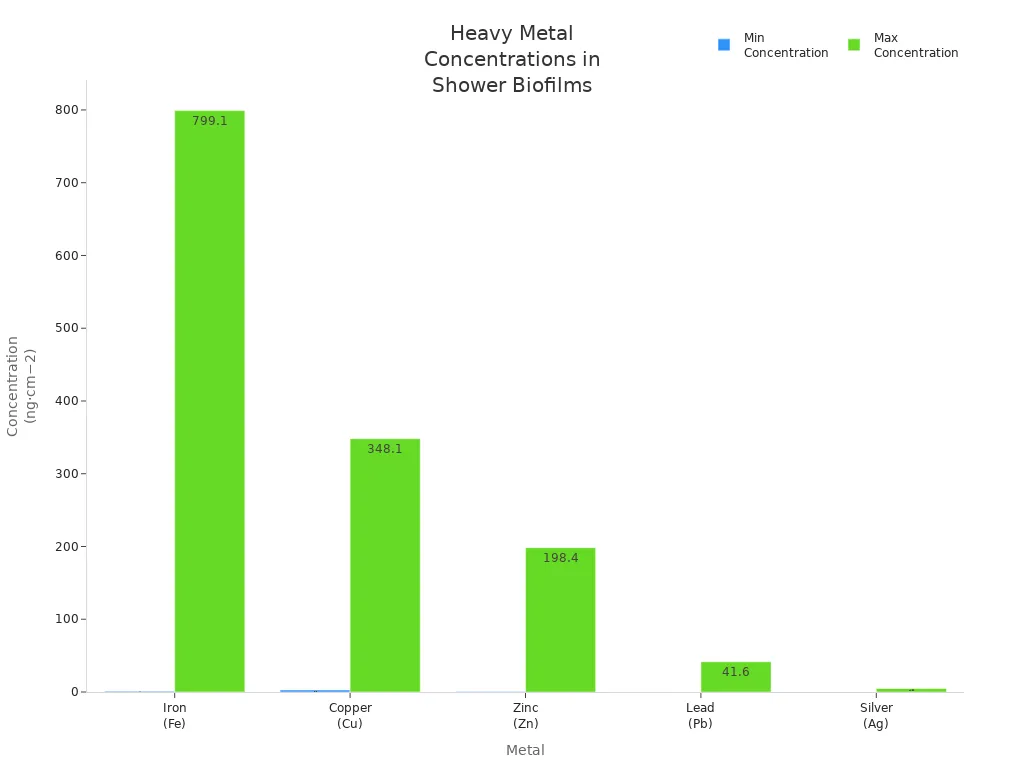
Contaminant Type |
Description & Sources |
Health Risks & Effects |
|---|---|---|
Lead |
Gets into water from pipes and plumbing materials |
Can cause nerve damage, learning problems, kidney issues, high blood pressure, birth defects; builds up in the body |
Mercury |
Found in different forms; gets in water from the environment |
Can hurt the nervous system and kidneys; causes problems for children |
Other Impurities
Shower water can have more than just chemicals and metals. It can also have rust, bacteria, mold, microplastics, and viruses. Rust can block pores and bother your skin. Bacteria like E. coli can cause infections. Mold can make eczema or rashes worse. Microplastics can scratch your skin and bring in bad chemicals. Viruses can get into your body through your skin or eyes. These things make water quality worse and showers less safe. Many people use filters to get rid of these things. The table below lists common impurities and what they can do to your health:
Impurity |
Health Impact |
|---|---|
Rust |
Can irritate skin and block pores |
Bacteria |
Can cause skin infections like boils or impetigo |
Heavy Metals |
Can irritate skin and cause health problems later |
Chlorine & Chloramines |
Can dry out skin and hair |
Microplastics |
Can scratch skin and get stuck in hair |
Mold |
Can cause skin irritation or eczema |
Viruses |
Can cause infections through skin and eyes |
Having good water in the shower keeps your skin, hair, and body healthy. Filters that take out chlorine, heavy metals, and other chemicals make water better and lower health risks.
The Science of Shower Filter Shower Heads
Shower filter heads use science to clean water. They help take out chlorine, heavy metals, and other bad things. Many studies say these filters make shower water safer for skin and hair. The main science ideas are adsorption, redox reactions, and ion exchange. Each one helps the filter make water better.
Adsorption
Adsorption means some materials catch bad stuff on their surface. Activated carbon is used a lot for this. It has many tiny holes like a sponge. When water goes through, these holes grab chlorine, organic compounds, and bad smells. Studies show activated carbon can take out chlorine and make water taste and smell better.
The table below shows how filter materials use adsorption:
Filter Material |
Adsorption Mechanism |
Target Contaminants |
Description |
|---|---|---|---|
Carbon Block |
Adsorption on porous activated carbon surface |
Chlorine, organic compounds, VOCs |
Activated carbon traps contaminants by binding them to its surface. |
Zeolite |
Ion exchange and physical adsorption |
Heavy metals, ammonia |
Zeolite traps metals and ammonia through its microporous structure. |
A thicker filter catches more bad stuff, so adsorption goes up. If water moves slower, the filter works better. But when the filter is full, it cannot catch more. Changing the filter often keeps it working well. Studies say adsorption is important for taking out bad chemicals from shower water.
Redox Reactions
Redox reactions move electrons between things. In shower filters, KDF-55 uses copper and zinc to do redox reactions. This changes bad chemicals into safer ones. For example, KDF-55 turns chlorine into safe chloride ions. It also lowers heavy metals like lead and mercury. Calcium sulfite reacts fast with chlorine, even in hot water, making it safe. This is like how a car’s converter makes gases safer.
Many studies say redox reactions help clean water. These reactions take out chlorine and heavy metals. This makes water safer for daily use. Redox media in filters also help stop skin and hair problems from chlorine. Science shows redox reactions in filters make water better and lower health risks.
The table below shows what redox media do in shower filters:
Redox Media |
Role in Redox Reaction |
Effect on Harmful Chemicals |
|---|---|---|
KDF-55 (Copper/Zinc) |
Facilitates electron transfer (redox process) |
Converts chlorine to chloride; removes heavy metals like lead and mercury |
Calcium Sulfite |
Rapid chemical reaction with chlorine |
Transforms chlorine into safe salts, effective even in hot water |
Vitamin C (Ascorbic Acid) |
Reacts chemically with chlorine and chloramines |
Removes up to 99% of chlorine and chloramines, neutralizing irritants |
Note: Redox reactions in filters help take out chlorine and heavy metals. This makes showers healthier.
Ion Exchange
Ion exchange is another way shower filters work. This uses resin beads or minerals like zeolite. These have charged spots that grab and swap bad ions for safer ones. For example, cation exchange resins take out heavy metals like lead and mercury. They swap them for safe hydrogen ions. Anion exchange resins swap bad negative ions for safer ones like hydroxide.
Studies say ion exchange is great for taking out heavy metals from water. Many home filters use this, often with activated carbon, to work better. Research shows ion exchange helps lower dangerous metals in shower water. This protects your skin and hair.
The table below shows the main science ideas in shower filters:
Scientific Principle |
Mechanism Description |
Effect on Water Contaminants |
|---|---|---|
Adsorption |
Activated carbon captures chlorine and organic compounds on its porous surface |
Reduces chlorine, odors, and organic chemicals |
Redox Reactions |
KDF-55 media (copper and zinc) converts chlorine into chloride ions and reduces heavy metals like lead and mercury |
Transforms harmful chlorine and heavy metals into safer forms |
Chemical Neutralization |
Materials like vitamin C and calcium sulfite chemically react with chlorine and chloramines |
Converts harmful chemicals into safer substances |
Ion Exchange |
Zeolite or resin beads swap harmful metal ions for safer ions like sodium or potassium |
Lowers levels of heavy metals and other contaminants |
Physical Filtration |
Fine screens physically trap dirt and particles |
Removes larger impurities from water |
Shower filter heads like the Cobbe DS use all these science methods in one system. This helps the filter take out chlorine, heavy metals, and other bad things. Science supports using these methods for cleaner, healthier showers.
Filter Media in Filtered Showerheads
KDF-55
KDF-55 is a strong filter used in many showerheads. It uses copper and zinc to clean water with a redox process.
KDF-55 changes chlorine into safe chloride ions very fast.
It takes out almost all heavy metals like lead, mercury, and nickel.
This filter stops bacteria, mold, and algae from growing inside.
KDF-55 helps stop scale from building up, so showers stay cleaner.
It works well with other filters, making the whole system better.
KDF-55 is safe and approved by NSF, EPA, and FDA. It lasts a long time.
Hot water does not hurt KDF-55, so it works great in showers.
Calcium Sulfite
Calcium sulfite is another important filter in showerheads. It removes chlorine from water very fast, even when water is hot. The table below shows how calcium sulfite compares to other filters for chlorine removal:
Filter Media |
Effectiveness in Chlorine Removal |
Performance in Hot Water |
Additional Notes |
|---|---|---|---|
Calcium Sulfite |
Very good and fast |
Works well in all water temperatures, even hot |
Great for showers with lots of water flow |
Good for organics, taste, smell |
Best in cool water; does not work well above 80°F |
Not best for hot water chlorine removal |
|
Vitamin C |
Good at removing chlorine |
Works in hot water but does not last long |
Needs to be changed often |
KDF |
Proven by science, works well |
Good at removing chlorine |
Needs enough filter to work well |
Calcium sulfite turns chlorine into safe chloride ions. This makes it a top pick for shower filters that need to work fast and in hot water.
Activated Carbon
Activated carbon is a popular filter in many showerheads. It has lots of tiny holes that trap chemicals and bad smells.
Granular activated carbon can take out most chlorine from water.
It also grabs chemicals like VOCs and trihalomethanes that can be harmful.
Activated carbon works best in cool water, but it still helps in showers.
Many filters use activated carbon to make water safer and cleaner.
Mineral Balls
Mineral balls are another part of some shower filters. They do not take out hard minerals or metals. Instead, mineral balls add good minerals to the water and make it feel nicer on skin and hair. They work with KDF-55, calcium sulfite, and activated carbon to make showers better. Mineral balls help water feel softer and more pleasant, which people notice right away.
The Cobbe DS Filter Shower Head uses KDF-55, calcium sulfite, and mineral balls in its special filter. This shower filter is strong, eco-friendly, and lasts a long time. Using these filters together gives you cleaner and safer water every time you shower.
Benefits of a Filtered Shower Head
Softer Skin and Hair
Filtered shower heads help make skin and hair softer. Tap water has chemicals like chlorine and heavy metals. These can take away the natural oils from your skin and hair. This can make your skin dry and your hair break. Doctors say using a filter is a good idea. Filters take out these bad things. Science shows hard water and chemicals can cause problems. They can make minerals build up and hurt your scalp. When a filter removes these things, your skin keeps more moisture. Your hair is easier to brush and style. People say their scalp feels better and they get less acne. Hair looks shinier too. These are good reasons to use a filtered shower head if you want healthy skin and hair.
Reduced Chemical Exposure
A filter in your shower head can lower the amount of chemicals you touch. It can take out up to 95% of chlorine and other chemicals. Normal shower heads do not clean the water. This means you touch chlorine, heavy metals, and other bad things. These can dry your skin, hurt your hair, and even make it hard to breathe. Multi-stage filters like KDF-55 and calcium sulfite work well, even with hot water. They help stop skin from getting irritated and keep hair healthy. People who use these filters feel more comfortable during and after showers. The filter makes sure you get clean water every time. This makes showers safer and nicer.
Healthier Showers
Filtered shower heads give more health benefits than just soft skin and hair. Clean water helps stop skin problems like eczema and acne. It also means you breathe in fewer bad chemicals when you shower with hot water. People with sensitive skin or asthma feel better and have fewer problems with a filter. The filter blocks many chemicals and other bad things. Every shower helps you stay healthy. Families who want to stay healthy and enjoy clean water often pick filtered shower heads for every day.
Tip: A filtered shower head can make showers more comfortable. It helps your hair and skin and is good for everyone at home.
Effectiveness and Myths
Do Filter Shower Heads Really Work?
A lot of people ask if shower filter heads really take out bad things from water. Tests by outside labs and groups like NSF/ANSI Standard 177 show that good shower filters can cut chlorine by more than 90%. Labs such as IAPMO check top filters, like the Cobbe DS Filter Shower Head. These filters use KDF-55, calcium sulfite, and activated carbon to take out chlorine, heavy metals, and other bad stuff. They also keep water flowing strong and meet tough rules. Many people say their skin feels softer and their hair looks shinier after using a certified filter. Studies show that shower filters with enough KDF and calcium sulfite work well to remove bad things, but cheap filters do not work as well.
Outside labs check filters to make sure they lower chlorine.
Good filters can cut chlorine by up to 96.6% during their use.
People see better skin and hair with certified shower filter heads.
Water Pressure and Flow
Some people think a filter will make the shower weaker. Experts and tests show most shower filter heads do not lower water pressure or flow much. Certified filters keep water moving at normal rates, about 2.5 gallons each minute. This means you still get a strong shower and cleaner water. The Cobbe DS Filter Shower Head is made to give high pressure, even with its filter.
Tip: Pick a certified shower filter head to get both clean water and strong flow.
Common Misconceptions
There are many myths about shower filter heads. Some people think these filters take out all chlorine and minerals, but they mostly lower chlorine and heavy metals. Shower filters do not make water soft because they do not take out calcium or magnesium. Another myth is that all filters work the same way. Different filters go after different bad things, so results are not always the same. Some people think filters make hair fall out, but studies show they help protect hair by lowering harsh chemicals. New shower filter heads also keep water pressure strong, so it is not true that filters slow down the water.
Myth |
Fact |
|---|---|
Filters take out all chlorine |
Most filters lower, not remove, chlorine |
Filters make water soft |
They do not take out hard minerals |
All filters work the same |
Different filters remove different bad things |
Filters lower water pressure |
Good filters keep water strong |
Filters cause hair loss |
Filters help keep hair and scalp healthy |
Shower filter heads give real benefits, but people should know what these filters can and cannot do.
Choosing and Maintaining a Filter Shower Head
What to Look For
Start by checking what is in your water. Some water has lots of chlorine. Other water has heavy metals or dirt. Pick a filter shower head that matches your water problems. KDF-55 is good for chlorine and heavy metals. Activated carbon helps with chlorine and bad smells. Calcium sulfite takes out chlorine fast, even when water is hot. Multi-stage filters use more than one filter type for better results. Look for filters with NSF-177 or NSF-372 certifications. These show the filter is high quality. Filters that last longer save you money and time. Make sure the filter fits your shower pipes. Some filters have spray settings you can change. But water quality should be the most important thing.
Installation Tips
Most people can put in a filter shower head easily. First, take off your old shower head with a wrench or pliers. Clean the shower arm threads and wrap them with thread seal tape. This stops leaks. Take off any plastic from the new filter cartridge. Screw on the new filter shower head by hand. Use a wrench if you need to make it tighter. Run warm water for one minute to wash out dust. Check for leaks and move the shower head to the right angle. The Cobbe DS Filter Shower Head fits most showers and has easy instructions. You can finish in a few minutes and get cleaner water right away.
Filter Replacement
Change your filter often to keep water clean. Most filters need to be changed every 2 to 3 months. This can change if your water is very dirty or you use a lot of water. If water flow gets weak, smells bad, or your skin feels dry, it is time to change the filter. Cobbe tells you when to replace the filter and helps customers if needed. Keep extra filters at home so you do not run out. Clean the shower head and rinse the filter screen to help it last longer. Follow the maker’s schedule to keep your filter working well and your water clean.
Tip: Write down the date when you last changed your filter on a calendar. This helps you remember and keeps your water clean.
Shower filter heads use science to take out bad things. They remove chlorine, heavy metals, and other impurities from water. This makes water safer for your skin and hair. Many people see their hair get softer after using a filter. They also have fewer skin problems. You can test your water at home if you want. Getting a filtered shower head like the Cobbe DS can help your health every day. Cleaner showers make families feel good all the time.
Try using a filter shower head and see how it helps you.
FAQ
How often should someone replace the filter in a shower head?
Most filters should be changed every 2 or 3 months. If you use a lot of water, change it more often. Dirty water also means you need to change it sooner. Write down the date when you put in a new filter. This helps you remember and keeps your water clean.
Can a filtered shower head help with hard water?
Filtered shower heads take out chlorine and heavy metals. They do not remove calcium or magnesium from water. These filters do not make hard water soft. If you want soft water, you need a whole-house water softener.
Will a filter shower head lower water pressure?
Good filter shower heads, like the Cobbe DS, keep water strong. They have flow restrictors to save water but do not lower pressure. You still get a powerful shower and cleaner water.
Are filtered shower heads safe for children and pets?
Yes, filtered shower heads are safe for kids and pets. They take out bad chemicals and metals from water. This helps stop skin problems and makes baths healthier for everyone.
